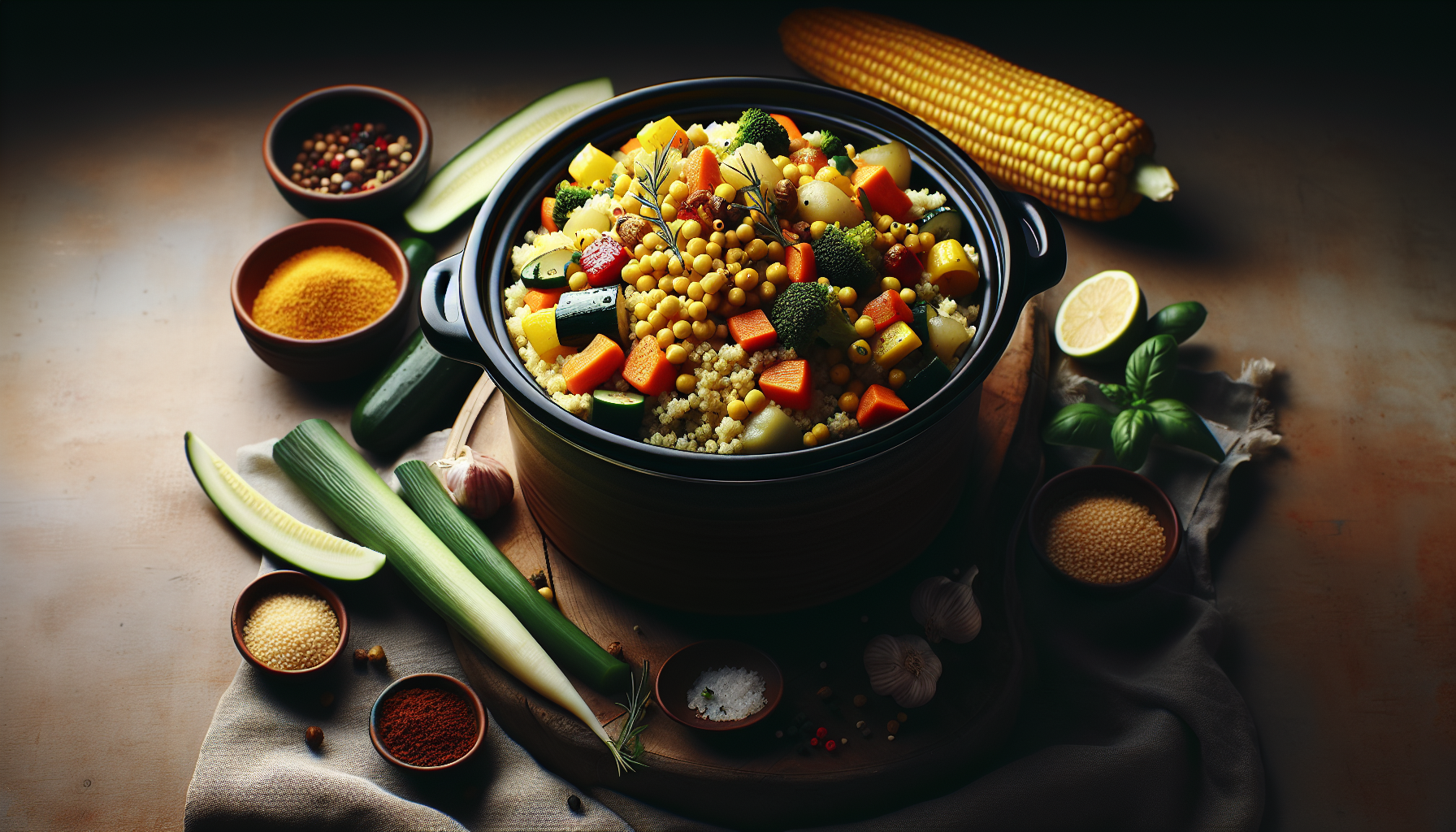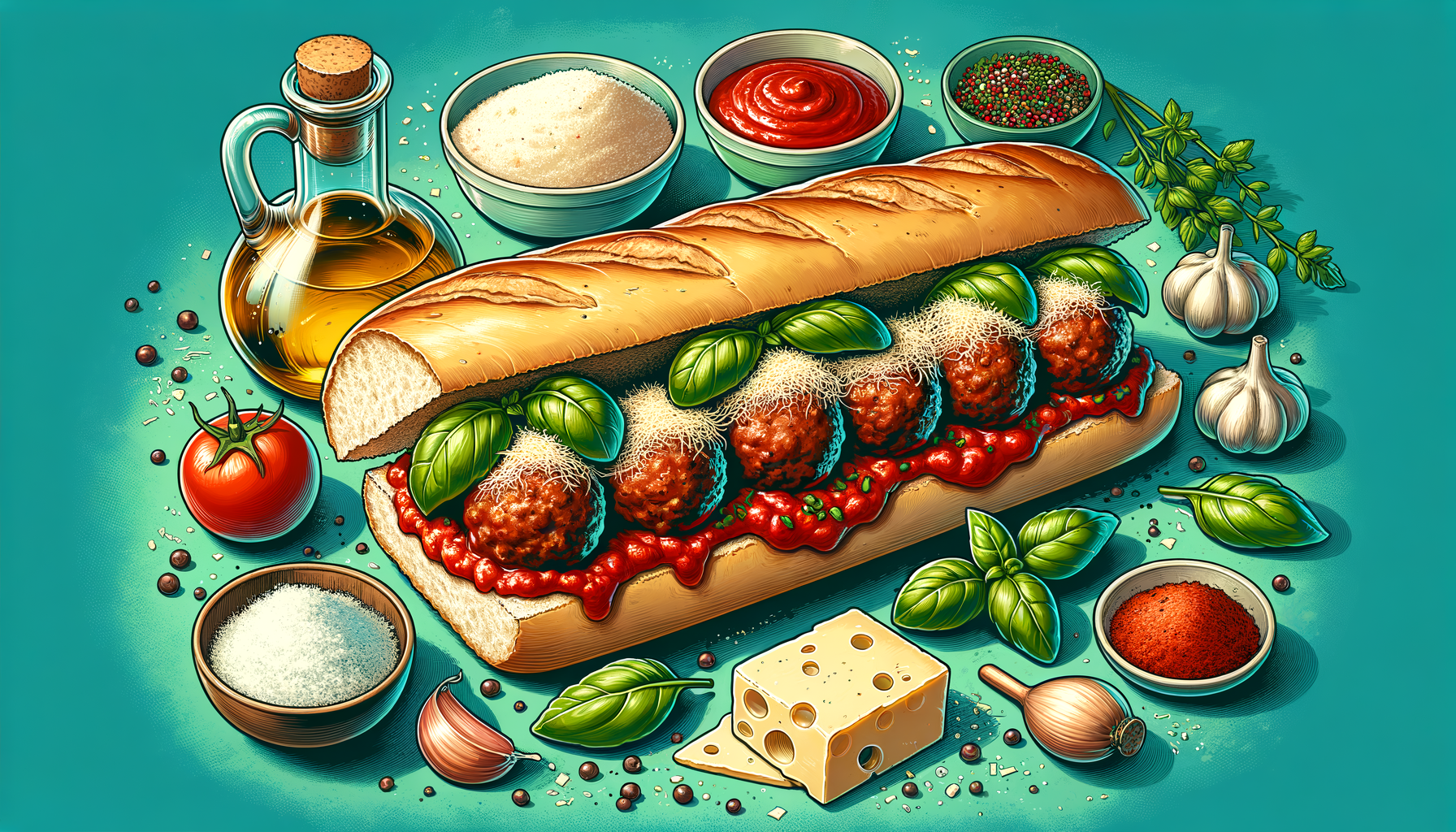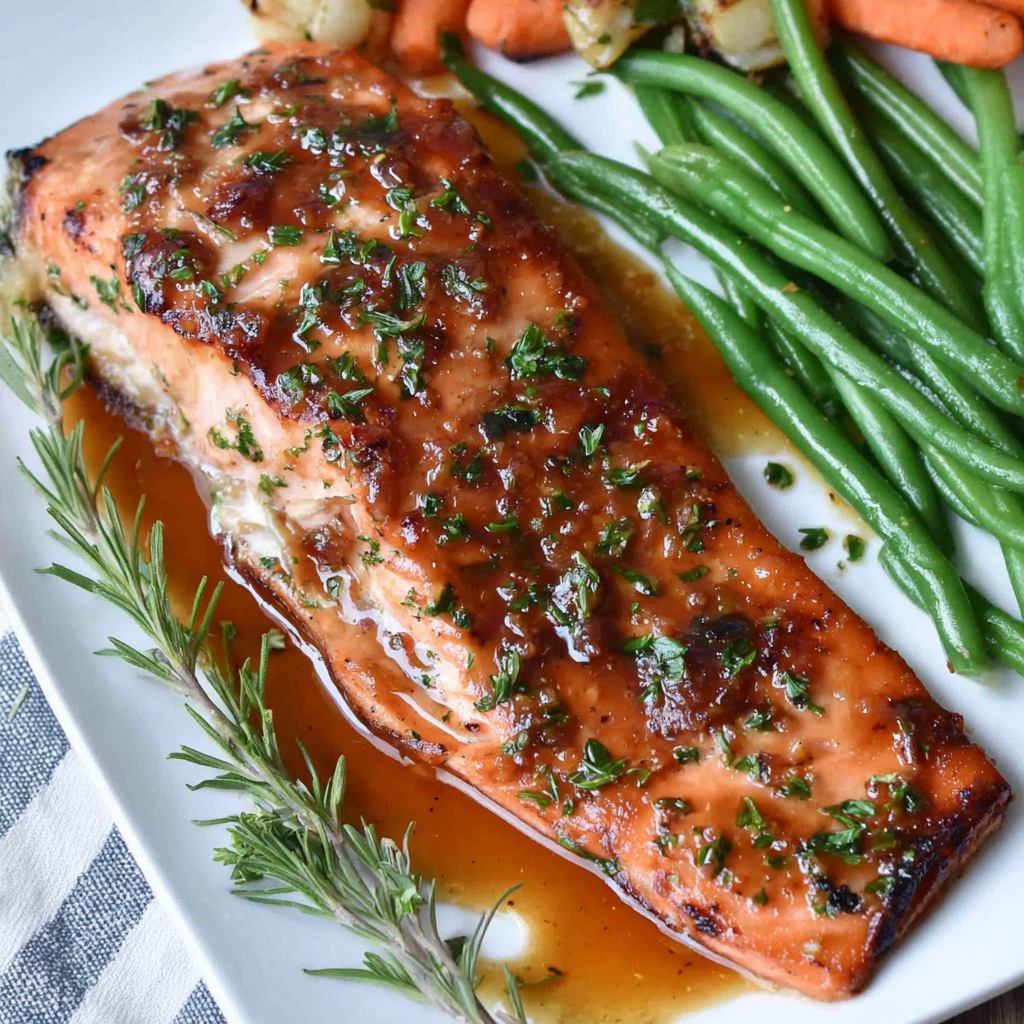Moroccan Couscous in the Slow Cooker: Fluffy, Fragrant Grains with Tender Vegetables
Bring the soul of a Moroccan market to your kitchen with slow-cooker ease. This richly spiced vegetable-and-chickpea couscous delivers tender, saucy goodness over impossibly fluffy grains—no couscoussier required. Learn the cultural roots, smart techniques, and chef-tested tips that make this a crowd-pleasing, weeknight-friendly feast.

Moroccan Couscous in the Slow Cooker: Fluffy, Fragrant Grains with Tender Vegetables
Few dishes feel as welcoming—or as weeknight-friendly—as Moroccan couscous. Traditionally steamed in a couscoussier and served under a generous ladle of slow-simmered vegetables and meat, it’s the kind of communal meal that turns a table into a celebration. On Tagine Time, we love honoring tradition while making it accessible. In this guide, you’ll discover how to harness your slow cooker to build deep, layered flavors in the stew, then finish with cloud-light couscous that’s never soggy or clumpy.
What Exactly Is Moroccan Couscous?
Moroccan couscous is a staple across North Africa—tiny granules of durum wheat semolina rolled and dried, traditionally steamed multiple times over a bubbling pot of broth or stew. In Morocco, you’ll often find it gracing Friday tables, generously heaped, perfumed with saffron or ras el hanout, and crowned with a cascade of vegetables, chickpeas, and sometimes tender lamb or chicken. While each region, and even each household, has a unique approach, a few constants remain: balanced spice, a hint of sweet from dried fruit, and couscous grains that feel airy and distinct.
Why Use a Slow Cooker?
The slow cooker is the perfect tool for the hearty sauce (or “stew”) that tops couscous. Low-and-slow heat coaxes sweetness from onions and carrots, turns squash silky, and lets spices mellow into a round, warm backbone. The one caveat: the couscous itself shouldn’t simmer for hours, or it can turn gluey. Instead, you’ll make the flavorful stew in the slow cooker, then bloom the couscous separately in hot broth (ideally ladled from the cooker at the end) for grains that stay bouncy and fluffy. The result is all-day flavor with restaurant-worthy texture.
Why You’ll Love This Slow-Cooker Moroccan Couscous
- Hands-off cooking: Build your base, set it, and let the slow cooker do the heavy lifting while you go about your day.
- Vibrant flavor, minimal effort: Warming spices like cumin, coriander, ginger, and cinnamon bloom gently over hours.
- Flexible and accommodating: Keep it vegetarian with chickpeas or add chicken or lamb—both versions shine.
- Meal-prep friendly: The stew keeps beautifully, and couscous fluffs back up with a splash of broth.
- Balanced and nourishing: Tender vegetables, legumes, and grains deliver comfort and good nutrition in every serving.
Core Ingredients and What They Do
Couscous: Choosing the Right Type
For classic Moroccan texture, reach for small-grain couscous (often just labeled “couscous”). It hydrates quickly, which is ideal when you’re blooming it with hot broth at the end of cooking. Israeli/pearl couscous (the larger, pasta-like pearls) is delicious too, but it performs differently—those pearls need simmering like pasta and are best cooked separately on the stovetop before folding into the stew. For this recipe’s method and timing, small-grain couscous is your best friend.
Spices: The Warm, Fragrant Backbone
Moroccan kitchens lean on cumin, coriander, paprika, ginger, turmeric, and cinnamon. A pinch of saffron adds perfume and golden hue, while harissa or cayenne brings a restrained heat. The goal is a layered warmth, not a fiery punch. If you keep a good ras el hanout blend in your pantry, it’s a great shortcut—use it as the primary seasoning and complement with extra cumin and ginger.
Vegetables and Legumes: Color, Body, and Comfort
Onions, carrots, and bell peppers form a sweet, soft base. Butternut squash gives creamy heft without dairy, and zucchini adds delicate freshness (stir it in toward the end to avoid overcooking). Chickpeas bring protein and pleasing bite. Tomatoes with their juice round out the sauce, and a handful of raisins or chopped apricots offers the signature sweet-savory balance that defines many Moroccan dishes.
Liquids and Finishing Touches
Use low-sodium vegetable or chicken broth so you can control salt levels. A drizzle of honey softens acidity, while lemon juice brightens everything at the end. For garnishes, think toasted almonds, chopped parsley or cilantro, and, for an authentic pop, preserved lemon rind and a few briny green olives.
The Slow-Cooker Advantage (and the One Smart Workaround)
Slow cookers are dream machines for flavor development, but they’re less kind to quick-cooking grains. The solution is to keep each component in its ideal cooking lane: let the stew go low and slow, then bloom couscous off-heat with hot liquid. This approach reproduces the spirit of a traditional couscoussier where steam from the pot cooks the grains without drowning them.
Here’s the flow you’ll follow:
- Build your base: Season vegetables (and optional protein) with a spice paste so the flavors cling. Layer everything into the cooker with tomatoes and broth.
- Cook low and slow: Let sweetness develop and squash soften until spoon-tender.
- Bloom the couscous: Transfer a measured amount of hot cooking liquid—or boiling broth—to a bowl of couscous, cover, and rest briefly.
- Finish and garnish: Fluff grains, add herbs and lemon, then crown with the silky stew, almonds, and preserved lemon.
Technique Deep Dive: Fluffy Couscous, Every Time
Toast and Coat
A teaspoon or two of olive oil mixed through the dry couscous before hydrating helps the grains separate. Some cooks also warm the dry couscous briefly in a skillet to toast the semolina, adding a nutty note and additional resilience against clumping.
Measure the Liquid
Most small-grain couscous thrives with 1.25 to 1.5 cups hot liquid per cup of couscous. If you prefer firmer grains, lean toward 1.25; for softer, 1.5. After pouring the hot liquid, cover the bowl tightly for about 10 minutes, then fluff with a fork and a knob of butter or a drizzle of olive oil. Resist stirring during that initial rest; it can compact the grains.
Season in Layers
Season the stew generously but save final adjustments for the end, after reduction and vegetable sweetness have emerged. Season the couscous liquid as well—salted, flavorful broth makes every grain count. Finish with lemon for lift and fresh herbs for contrast.
Vegetables with Texture
Zucchini and olives benefit from a shorter stint in the cooker. Stir them in during the last 30–60 minutes so they keep shape and pop. For squash, uniform 1-inch cubes become silken without dissolving during a four- to five-hour low cook.
Cultural Context: A Friday Tradition, Adapted with Care
In Morocco, couscous is more than dinner—it’s a ritual of hospitality. The grains are rinsed, aerated, and steamed repeatedly while a pot of spiced broth simmers below. Families serve it on a broad platter, with the meat or vegetables arranged attractively on top. Our slow-cooker adaptation respects those principles—aromatics, spice harmony, and gentle cooking—while acknowledging modern kitchens and tight schedules. Think of the slow cooker as a reliable sous-chef while you prepare the finishing touches.
Pairings, Garnishes, and Serving Ideas
- Heat and sweetness: Serve with harissa on the side and a small bowl of honey for diners to calibrate heat and sweet.
- Crunch: Toasted almonds or pistachios add welcome contrast to the tender vegetables.
- Freshness: A chopped herb salad—parsley, cilantro, mint—wakes up the plate.
- Accompaniments: Warm flatbread or khobz soaks up the spiced juices beautifully.
- Finishers: A sprinkle of preserved lemon rind and a squeeze of lemon juice add sparkle right before serving.
Common Mistakes (and How to Avoid Them)
Letting Couscous Sit in the Cooker
Tempting, but don’t. Long exposure to wet heat turns couscous mushy. Always bloom it off-heat with measured hot liquid, then fluff.
Underseasoning the Liquid
Bland broth equals bland grains. Taste your broth before you pour it over the couscous; it should taste pleasant and just slightly saltier than you want the final dish.
Throwing All Vegetables in at Once
Use the slow cooker’s timing to your advantage: hearty veg like squash can go in early; delicate ones like zucchini should wait until the end so they retain color and snap.
Skipping the Acid
A squeeze of lemon at the finish makes a dramatic difference, lifting the warm spices and rounding the stew’s richness.
Variations Worth Trying
Chicken Couscous
Chicken thighs become succulent in the slow cooker and infuse the broth with savory depth. Brown them first if you have time; if not, the low-and-slow bath still works wonders.
Lamb with Prunes or Apricots
For a celebration platter, slow-cook lamb shoulder until fork-tender and garnish with prunes or apricots for that classic sweet-savory Moroccan contrast.
Pearl Couscous (Israeli-Style)
Swap small-grain couscous for pearl couscous. Simmer the pearls separately in salted water until al dente, drain, then fold into the finished stew with herbs and lemon.
Vegetarian Power
Double the chickpeas and add cubes of roasted eggplant at the end. A touch more harissa brings satisfying depth without meat.
Make-Ahead, Storage, and Reheating
The stew portion actually improves after a night in the fridge as the spices meld. Store the stew and couscous separately for the best texture. Reheat the stew gently on the stove or in the microwave; refresh couscous with a splash of hot broth and a fork fluff. If freezing, freeze the stew only—couscous is best made fresh and takes just minutes.
Frequently Asked Questions
Is couscous gluten-free?
No—couscous is made from wheat semolina. For a gluten-free option, try millet or quinoa; both pair wonderfully with the slow-cooked Moroccan stew.
Can I cook the couscous directly in the slow cooker?
It’s not recommended. You’ll likely get mushy results. Bloom couscous in a bowl with hot broth instead for the best texture.
What can I use instead of preserved lemon?
Finely grated lemon zest plus a splash of lemon juice is a great stand-in. It won’t bring the same saline bite, but it adds brightness.
How spicy is this?
Moroccan spice is about warmth, not heat. Add harissa or cayenne to taste if you want more kick.
Final Thoughts
Moroccan couscous is about generosity—of flavor, color, and connection. Your slow cooker makes the most time-intensive part effortless, while a quick, thoughtful couscous bloom gives you that classic, airy texture. Whether you serve it vegetarian with chickpeas or luxurious with tender chicken or lamb, this is a deeply comforting, high-reward meal that fits weeknights and dinner parties alike. Gather friends, warm some flatbread, and let the spices do the rest.
Pro Tips
Toast the dry couscous in a skillet for 2–3 minutes to deepen flavor and help keep grains separate.
Use flavorful, low-sodium broth so you can season assertively without oversalting.
Stir delicate vegetables (like zucchini) and olives in during the last hour to preserve color and bite.
If adding chicken or lamb, trim excess fat to keep the sauce bright and not greasy.
Fluff couscous with a fork; avoid pressing or stirring while it hydrates so it stays airy.
Taste and adjust with lemon and salt at the end—acid brings the spices into focus.
For company, garnish generously: toasted almonds, chopped herbs, preserved lemon, and a drizzle of good olive oil.
Store stew and couscous separately; refresh couscous with a splash of hot broth before serving.
This nourishing moroccan couscous in the slow cooker: fluffy, fragrant grains with tender vegetables recipe is sure to be a staple in your kitchen. Enjoy every moist, high protein slice — it is perfect for breakfast or as a wholesome snack any time.
Tags
Moroccan Couscous in the Slow Cooker: Fluffy, Fragrant Grains with Tender Vegetables
This Moroccan Couscous in the Slow Cooker: Fluffy, Fragrant Grains with Tender Vegetables recipe makes perfectly juicy, tender, and flavorful steak every time! Serve with potatoes and a side salad for an unforgettable dinner in under 30 minutes.

Last Step: Please leave a rating and comment letting us know how you liked this recipe! This helps our business to thrive and continue providing free, high-quality recipes for you.
Did You Make This?
Leave a comment & rating below or tag
@kitchenfunwithmy3sons on social media!

Categories:
You might also like...

Instant Pot Japanese Sushi at Home: Foolproof Rice and Rolls for Beginners
Craving Japanese sushi at home? Learn how the Instant Pot makes silky, glossy sushi rice more consistent, then turn it into beautiful maki, nigiri, and hand rolls. Get cultural context, pro tips, and pairing ideas—plus a full step-by-step recipe with ingredients in the card below.

Moroccan Couscous in the Slow Cooker: Fluffy, Fragrant Grains with Tender Vegetables
Bring the soul of a Moroccan market to your kitchen with slow-cooker ease. This richly spiced vegetable-and-chickpea couscous delivers tender, saucy goodness over impossibly fluffy grains—no couscoussier required. Learn the cultural roots, smart techniques, and chef-tested tips that make this a crowd-pleasing, weeknight-friendly feast.

Classic Italian Meatball Subs
Toasty rolls piled with tender meatballs, rich marinara, and bubbling mozzarella for a saucy, crowd-pleasing sandwich night everyone loves.

Did You Make This?
Leave a comment & rating below or tag @kitchenfunwithmysons on social media!
Rate This Recipe
Share This Recipe
Enjoyed this recipe? Share it with friends and family, and don't forget to leave a review!
Comments (1)
This recipe looks amazing! Can't wait to try it.
Comments are stored locally in your browser. Server comments are displayed alongside your local comments.

Hi, I'm Royal!
What's Popular
30-Minute Meals!
Join to receive our email series which contains a round-up of some of our quick and easy family favorite recipes.

